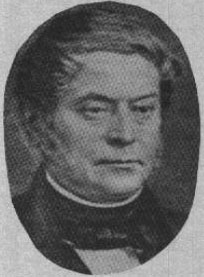Charles-Gabriel Pravaz
Charles-Gabriel Pravaz , also Charles Gabriel Pravaz (born March 24, 1791 in Pont-de-Beauvoisin near Lyon , Department of Isère, † June 24, 1853 in Lyon) was a French surgeon and orthopedic surgeon , known for the development of the hypodermic syringe .
Life
Pravaz was the son of a doctor, served in the military until 1815 and initially studied at the École polytechnique , but stopped when his mother fell ill with tuberculosis and studied medicine in Paris. In 1824 he received his doctorate. Inspired by the observation of back deformations in young girls ( scoliosis ), he specialized in orthopedics. In 1829 he and J. Guerin founded the Institut Orthopédique du Château de la Muette in Passy with a branch in Lyon. When he separated from Guerin in 1835, he took over the entire branch in Lyon (Institut Orthopédique et Pneumatique Bellevue). There he developed some deserving treatment methods for scoliosis and congenital hip dislocation from today's perspective . But he had no students in orthopedics - his methods were given up after his death and his institute closed. He is buried in Sainte-Foy-lès-Lyon.
Invention of the injection syringe
Although Robert Boyle and Christopher Wren had already experimented with syringes in the 17th century, the invention of the syringe is usually attributed to the French field surgeon Dominique Anel (1679–1730), who used it to clean wounds. It was similar to the enema syringes used at the time , only smaller. For injections, Pravaz invented a syringe ( Pravaz syringe ) with 5 mm diameter and 1 cm³ content, which was made entirely of silver and which he had produced by the Établissement Charrière. The injection was still carried out using a screw mechanism. He used it to treat aneurysms by injecting iron (III) chloride . The Irish doctor Francis Rhynd (1801–1861) had already invented the hollow needle and tried it on a patient in 1844. Pravaz himself hardly tested his invention on a broad basis; their knowledge was spread in Europe in particular by the French surgeon LJ Béhier. This was soon followed by syringes which were partially or entirely (1869) made of glass, so that the liquid to be injected could be observed. The syringe enabled, among other things, the intravenous injection of morphine as a pain reliever, for example as early as 1853 by the Edinburgh doctor Alexander Wood (1817–1884), whose wife died of an overdose of injected morphine. It was also widely used to administer morphine in the American Civil War.
The Pravaz system (see cannula ) is named after him.
Web links
- French biography, Medarus.org
- Charles Pravaz, General Anesthesia website
- History of the Syringe, Discoveries in Medicine
Individual evidence
- ↑ Barbara I. Tshisuaka: Pravaz, Charles Gabriel. In: Werner E. Gerabek , Bernhard D. Haage, Gundolf Keil , Wolfgang Wegner (eds.): Enzyklopädie Medizingeschichte. De Gruyter, Berlin / New York 2005, ISBN 3-11-015714-4 , pp. 1181 f .; here: p. 1181.
- ^ Charles G. Pravaz: Traité théorique et pratique des luxations congénitales du fémur, suivi d'une appendices sur la prophylaxie des luxations spontanées. Lyon and Paris 1847.
- ^ Charles G. Pravaz: Sur un nouveau moyen d'opérer la coagulation du sang dans les artères, applicable à la guérison des anévrismes. In: Comptes Rendus Acad. Sc. Volume 36, (Paris) 1853, pp. 88-90.
| personal data | |
|---|---|
| SURNAME | Pravaz, Charles-Gabriel |
| ALTERNATIVE NAMES | Pravaz, Charles Gabriel |
| BRIEF DESCRIPTION | French surgeon and orthopedist known for developing the hypodermic syringe |
| DATE OF BIRTH | March 24, 1791 |
| PLACE OF BIRTH | Pont-de-Beauvoisin near Lyon , Isère department |
| DATE OF DEATH | June 24, 1853 |
| Place of death | Lyon |
